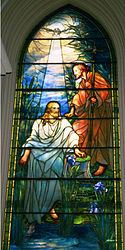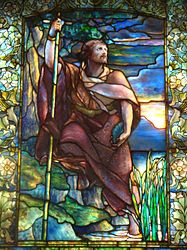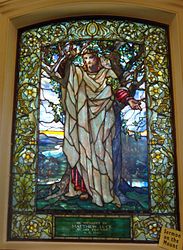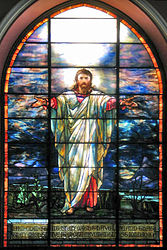Louis Comfort Tiffany
Louis Comfort Tiffany | |
|---|---|
 (c.1908) | |
| Born | February 18, 1848 New York City, New York, USA |
| Died | January 17, 1933 (aged 84) New York City, New York, USA |
| Resting place | Green-Wood Cemetery |
| Education | Pennsylvania Military Academy Eagleswood Military Academy |
| Known for | Favrile glass, Tiffany lamps |
| Spouse(s) | Mary Woodbridge Goddard (1872-1884; her death) Louise Wakeman Knox (1886-1904; her death) |
| Parent(s) | Charles Lewis Tiffany Harriet Olivia Avery Young |
Louis Comfort Tiffany (February 18, 1848 – January 17, 1933) was an American artist and designer who worked in the decorative arts and is best known for his work in stained glass. He is the American artist most associated with the Art Nouveau [1] and Aesthetic movements. Tiffany was affiliated with a prestigious collaborative of designers known as the Associated Artists, which included Lockwood de Forest, Candace Wheeler, and Samuel Colman. Tiffany designed stained glass windows and lamps, glass mosaics, blown glass, ceramics, jewelry, enamels and metalwork.[2]
Early life

Tiffany was born in New York City, New York, the son of Charles Lewis Tiffany, founder of Tiffany and Company; and Harriet Olivia Avery Young. He attended school at Pennsylvania Military Academy[3] in West Chester, Pennsylvania, and Eagleswood Military Academy in Perth Amboy, New Jersey. His first artistic training was as a painter, studying under George Inness in Eagleswood, New Jersey and Samuel Colman in Irvington, New York. He also studied at the National Academy of Design in New York City in 1866-67 and with salon painter Leon-Adolphe-Auguste Belly in 1868-69. Belly's landscape paintings had a great influence on Tiffany.[4]
Career

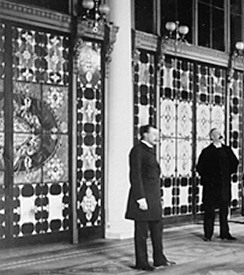
Tiffany started out as a painter, but became interested in glassmaking from about 1875 and worked at several glasshouses in Brooklyn between then and 1878. In 1879, he joined with Candace Wheeler, Samuel Colman and Lockwood de Forest to form Louis Comfort Tiffany and Associated American Artists. The business was short-lived, lasting only four years. The group made designs for wallpaper, furniture, and textiles. He later opened his own glass factory in Corona, New York, determined to provide designs that improved the quality of contemporary glass. [5]Tiffany's leadership and talent, as well as his father's money and connections, led this business to thrive.
In 1881 Tiffany did the interior design of the Mark Twain House in Hartford, Connecticut, which still remains, but the new firm's most notable work came in 1882 when President Chester Alan Arthur refused to move into the White House until it had been redecorated. He commissioned Tiffany, who had begun to make a name for himself in New York society for the firm's interior design work, to redo the state rooms, which Arthur found charmless. Tiffany worked on the East Room, the Blue Room, the Red Room, the State Dining Room and the Entrance Hall, refurnishing, repainting in decorative patterns, installing newly designed mantelpieces, changing to wallpaper with dense patterns and, of course, adding Tiffany glass to gaslight fixtures, windows and adding an opalescent floor-to-ceiling glass screen in the Entrance Hall.[6][7][8] The Tiffany screen and other Victorian additions were all removed in the Roosevelt renovations of 1902, which restored the White House interiors to Federal style in keeping with its architecture.[9]
A desire to concentrate on art in glass led to the breakup of the firm in 1885 when Tiffany chose to establish his own glassmaking firm that same year. The first Tiffany Glass Company was incorporated December 1, 1885 and in 1902 became known as the Tiffany Studios.
In the beginning of his career, Tiffany used cheap jelly jars and bottles because they had the mineral impurities that finer glass lacked. When he was unable to convince fine glassmakers to leave the impurities in, he began making his own glass. Tiffany used opalescent glass in a variety of colors and textures to create a unique style of stained glass. He developed the "copper foil" technique, which, by edging each piece of cut glass in copper foil and soldering the whole together to create his windows and lamps, made possible a level of detail previously unknown. This can be contrasted with the method of painting in enamels or glass paint on colorless glass, and then setting the glass pieces in lead channels, that had been the dominant method of creating stained glass for hundreds of years in Europe. (The First Presbyterian Church building of 1905 in Pittsburgh, Pennsylvania is unique in that it uses Tiffany windows that partially make use of painted glass.) Use of the colored glass itself to create stained glass pictures was motivated by the ideals of the Arts and Crafts movement and its leader William Morris in England. Fellow artists and glassmakers Oliver Kimberly and Frank Duffner, founders of the Duffner and Kimberly Company and John La Farge were Tiffany's chief competitors in this new American style of stained glass. Tiffany, Duffner and Kimberly, along with La Farge, had learned their craft at the same glasshouses in Brooklyn in the late 1870s.
In 1889 at the Paris Exposition, he is said to have been "Overwhelmed" by the glass work of Émile Gallé, French Art Nouveau artisan.[10] He also met artist Alphonse Mucha.
In 1893, Tiffany built a new factory called the Stourbridge Glass Company, later called Tiffany Glass Furnaces, which was located in Corona, Queens, New York, hiring the Englishman Arthur J. Nash to oversee it.[11] In 1893, his company also introduced the term Favrile in conjunction with his first production of blown glass at his new glass factory. Some early examples of his lamps were exhibited in the 1893 World's Fair in Chicago. At the Exposition Universelle (1900) in Paris, he won a gold medal with his stained glass windows The Four Seasons

He trademarked Favrile (from the old French word for handmade) on November 13, 1894. He later used this word to apply to all of his glass, enamel and pottery. Tiffany's first commercially produced lamps date from around 1895. Much of his company's production was in making stained glass windows and Tiffany lamps, but his company designed a complete range of interior decorations. At its peak, his factory employed more than 300 artisans. Recent scholarship led by Rutgers professor Martin Eidelberg suggests that a team of talented single women designers – sometimes referred to as the "Tiffany Girls"[12] – led by Clara Driscoll played a big role in designing many of the floral patterns on the famous Tiffany lamp as well as for other creations.[13][14][15][16][17]
Tiffany interiors also made considerable use of mosaics. The mosaics workshop, largely staffed by women, was overseen until 1898 by the Swiss-born sculptor and designer Jacob Adolphus Holzer.
In 1902, Tiffany became the first Design Director for Tiffany & Co., the jewelry company founded by his father.[18]
1911 saw the installation of an enormous glass curtain fabricated for the Palacio de Bellas Artes in Mexico City. It is considered by some to be a masterpiece.[10]
Tiffany used all his skills in the design of his own house, the 84-room Laurelton Hall, in the village of Laurel Hollow, on Long Island, New York completed in 1905. Later this estate was donated to his foundation for art students along with 60 acres (243,000 m²) of land, sold in 1949, and destroyed by a fire in 1957.
Personal life
Louis married Mary Woodbridge Goddard (c1850-1884) on May 15, 1872 in Norwich, Connecticut and had the following children:
- Mary Woodbridge Tiffany (1873–1963) who married Graham Lusk;
- Charles Louis Tiffany I (1874-1874);
- Charles Louis Tiffany II (1878–1947); and
- Hilda Goddard Tiffany (1879–1908), the youngest.
After the death of his wife, he married Louise Wakeman Knox (1851–1904) on November 9, 1886. They had the following children:
- Louise Comfort Tiffany (1887–1974), who married Rodman Drake DeKay Gilder;
- Julia DeForest Tiffany (1887–1973), who married Gurdon S. Parker then married Francis Minot Weld;[19]
- Annie Olivia Tiffany (1888–1892); and
- Dorothy Trimble Tiffany (1891–1979), who, as Dorothy Burlingham, later became a noted psychoanalyst and lifelong friend and partner of Anna Freud.

Tiffany died on January 17, 1933, and is buried in Green-Wood Cemetery in Brooklyn, New York.[20]
Tiffany is the great-grandfather of investor George Gilder.
Societies
- American Watercolor Society
- Architectural League
- Chevalier of the Legion of Honour in 1900
- Imperial Society of Fine Arts (Tokyo)
- National Academy of Design in 1880
- New York Society of Fine Arts
- Société Nationale des Beaux-Arts (Paris)
- Society of American Artists in 1877[citation needed]
Source:[20]
Awards and honors
- 1893: 44 medals, World Columbian Exposition (Chicago)
- 1900: gold medal, Chevalier of the Legion of Honour (France)
- 1900: grand prix, Paris Exposition
- 1901: grand prix, St. Petersburg Exposition
- 1901: gold medal, Buffalo Exposition
- 1901: gold medal, Dresden Exposition
- 1902: gold medal and special diploma, Turin Exposition
- 1904: gold medal, Louisiana Purchase Exposition in St. Louis[21]
- 1907: gold medal, Jamestown Exposition
- 1909: grand prize, Seattle Exposition
- 1915: gold medal, Panama Exposition
- 1926: gold medal, Philadelphia Sesquicentennial Exposition
Source:[20]
Collections
The Charles Hosmer Morse Museum of American Art in Winter Park, Florida houses the world's most comprehensive collection of the works of Louis Comfort Tiffany, including Tiffany jewelry, pottery, paintings, art glass, leaded-glass windows, lamps, and the Tiffany Chapel he designed for the 1893 World's Columbian Exposition in Chicago. After the close of the exposition, a benefactor purchased the entire chapel for installation in the crypt of the Cathedral of Saint John the Divine, New York in New York City. As construction on the cathedral continued, the chapel fell into disuse, and in 1916, Tiffany removed the bulk of it to Laurelton Hall. After the 1957 fire, Hugh McKean[22] (a former art student in 1930 at Laurelton Hall) and his wife Jeannette Genius McKean rescued the chapel,[23] which now occupies an entire wing of the Morse Museum which they founded. Many glass panels from Laurelton Hall are also there; for many years some were on display in local restaurants and businesses in Central Florida. Some were replaced by full-scale color transparencies after the museum opened.
A major exhibit at New York's Metropolitan Museum of Art on Laurelton Hall opened in November 2006. An exhibit at the New-York Historical Society in 2007 featured new information about the women who worked for Tiffany and their contribution to designs credited to Tiffany. In addition, since 1995 the Queens Museum of Art has featured a permanent collection of Tiffany objects, which continues Tiffany’s presence in Corona, Queens where the company's studios were once located. Reid Memorial Presbyterian Church in Richmond, Indiana has a collection of 62 Tiffany windows which are still their original placements, but the church is deteriorating and is jeopardy.
In 1906, Tiffany created stained glass windows for the Stanford White-designed Madison Square Presbyterian Curch located on Madison Avenue in Manhattan, New York City. The church was Tiffany’s place of worship, and was torn down in 1919 after the Metropolitan Life Insurance Company bought the land to build their new headquarters. Tiffany had inserted a clause in his contract stipulating that if the church were ever to be demolished then ownership of the windows would revert to him.[citation needed]
Tiffany enjoyed staying at the Mission Inn in Riverside, California, and had become friends with the founder of the Mission Inn, Frank Augustus Miller, so, after meeting with Miller in New York, Tiffany shipped the windows to the Mission Inn; they arrived there in 1924,[24] and were stored until the inn's St. Francis Chapel was completed in 1931. There are six rectangular windows and a 104” diameter window in the rear of the chapel, as well as another 104” diameter window is in the Galeria next to the chapel. A smaller window entitled “Monk At The Organ” featuring a Franciscan monk, is in St Cecelia’s Chapel,a wedding chapel, and is engraved with Tiffany’s signature. The St Francis Chapel was designed with the intent of prominently displaying Tiffany’s windows.[citation needed]
Significant collections of Tiffany windows outside the United States are the 17 windows in the former Erskine and American United Church, now part of the Montreal Museum of Fine Arts in Montreal, Canada,[25] and the two windows in the American Church in Paris, on the Quai d'Orsay, which have been classified as National Monuments by the French government; these were commissioned by Rodman Wanamaker in 1901 for the original American Church building on the right bank of the Seine.
The Haworth Art Gallery in Accrington, England[26] contains a collection of over 140 examples of the work of Louis Comfort Tiffany, including vases, tiles, lamps and mosaics. The collection, which claims to be the largest collection of publicly owned Tiffany glass outside of the United States, contains a fine example of an Aquamarine vase and the noted Sulphur Crested Cockatoos mosaic.
Gallery
- Stained glass windows
-
Girl with Cherry Blossoms (c. 1890)
-
The Tree of Life stained glass
-
Angel of the Resurrection (1904), in the Indianapolis Museum of Art
-
The New Creation, at Brown Memorial Presbyterian Church, Baltimore, Maryland
-
The Baptism of Christ, at Brown Memorial
-
Nicodemus Came to Him by Night, First Presbyterian Church, Lockport, NY
-
Christ the Consoler at Pullman Memorial Universalist Church, Albion, NY
-
Pastoral window at Second Presbyterian Church (Chicago, Illinois)
- Tiffany Lamps
-
Collection of Tiffany Lamps from the Virginia Museum of Fine Arts
-
Wisteria Table Lamp
See also
References
Notes
- ^ Lander, David. "The Buyable Past: Quezal Glass" American Heritage (April/May 2006)
- ^ Warmus, William. The Essential Louis Comfort Tiffany. New York: Abrams, 2001. Pages 5-8.
- ^ "Widener University: Distinguished Alumni". Widener University. Retrieved October 6, 2008.
- ^ Baal-Teshuva, Jacob. Louis Comfort Tiffany. Taschen. pp. 12–14.
- ^ Baal- Teshuva, Jacob. Louis Comfort Tiffany. Taschen. pp. 22–30.
- ^ "Victorian Ornamentation" on WhiteHouseMuseum.org
- ^ "White House Timelines: Architecture" on the White House Historical Association website
- ^ "White House Timelines: Decorative Arts" on the White House Historical Association website
- ^ "Theodore Roosevelt Renovation, 1902". The White House Museum. Retrieved December 12, 2013.
- ^ a b Encyclopædia Britannica
- ^ Campell, Gordon, ed. (2006). "Encyclopedia of Decorative Arts, vol. 2, pp. 464". Oxford University Press.
{{cite news}}:|author=has generic name (help)CS1 maint: multiple names: authors list (link) - ^ Gafffney, Dennis "Who Were the Tiffany Girls?" Antiques Roadshow website (January 12, 2015)
- ^ Taylor, Kate (February 13, 2007). "Tiffany's Secret Is Over". New York Sun. Retrieved November 16, 2009.
- ^ Johnson, Caitlin A. (April 15, 2007). "Tiffany Glass Never Goes Out Of Style". CBS News. Retrieved November 16, 2009.
- ^ Kastner, Jeffrey (February 25, 2007). "Out of Tiffany's Shadow, a Woman of Light". The New York Times. Retrieved November 16, 2009.
- ^ Goodman, Vivian (January 14, 2007). "Exhibition Honors Woman Behind the Tiffany Lamp". NPR. Retrieved November 16, 2009.
- ^ "Spare Times". The New York Times. April 7, 2006. Retrieved November 16, 2009.
- ^ "Louis Comfort Tiffany" on the Tiffany & Co. website
- ^ "Mrs. Parker Weds Francis M. Weld". The New York Times. August 18, 1930.
{{cite news}}:|access-date=requires|url=(help) - ^ a b c "Louis C. Tiffany, Noted Artist, Dies" New York Times (January 18, 1933)
- ^ Frelinghuysen, Alice Cooney; Obniski, Monica. "Louis Comfort Tiffany (1848–1933)". The Metropolitan Museum of Art. Retrieved July 31, 2013.
- ^ Hugh McKean
- ^ Jeannette Genius McKean
- ^ Riverside Daily Press (June 12, 1924)
- ^ Mathieu, Christine Johanne. The History of the Tiffany Windows at the Erskine and American Church, Montreal Concordia University (Master of Arts Thesis), 1999
- ^ a b "Haworth Art Gallery" on the Hyndburn Borough Council website
Sources
- Tiffany, Louis Comfort & de Kay, Charles. The Art Work of Louis C. Tiffany. Doubleday, Page & Co, New York, 1916
Further reading
- Couldrey, Vivienne. The Art of Louis Comfort Tiffany. Bloomsbury Publications, London, 1989, ISBN 0-7475-0488-1
- Duncan, Alastair. Tiffany Windows. Thames & Hudson, London, 1980, ISBN 978-0-500-23321-4
- Frelinghuysen, Alice Cooney (2006). Louis Comfort Tiffany and Laurelton Hall: an artist's country estate. New York: The Metropolitan Museum of Art. ISBN 1588392015.
- Koch, Robert H. Louis C. Tiffany - Rebel in Glass. 3rd Ed., Crown Publishers Inc, New York, 1982, ASIN B 0007DRJK0
- Logan, Ernest Edwin. The Church That Was Twice Born: A History of the First Presbyterian Church Of Pittsburgh, Pennsylvania 1773-1973. Pickwick-Morcraft, Pittsburgh, Pa., 1973
- Rago, David. "Tiffany Pottery" in American Art Pottery. Knickerbocker Press, New York, 1997
- "Featured Windows, Louis C. Tiffany and Tiffany Studios As Seen Through Michigan Stained Glass Windows". Michigan Stained Glass Census. May–June 2008. Retrieved February 18, 2012.
External links
- Chisholm, Hugh, ed. (1911). . Encyclopædia Britannica (11th ed.). Cambridge University Press.
- Tiffany Digital Collection from the Metropolitan Museum of Art Libraries
- Tiffany Treasures: Favrile Glass from Special Collections. Information on the 2009-2010 exhibition at The Corning Museum of Glass.
- Louis Comfort Tiffany - Artist and Businessman
- Louis Comfort Tiffany at Find a Grave
- Louis Comfort Tiffany objects in the collection of the Cooper-Hewitt, National Design Museum
- Louis Comfort Tiffany Pictorial Histories
- Press Release on Metropolitan 2006-07 exhibition about Laurelton Hall
- Tiffany and The Associated Artists' work on the Mark Twain House
- When Louis Tiffany Redesigned the White House
- Tiffany Lamps - Information, Valuation and History.
- Willard Memorial Chapel
- Virtual visit of Tiffany Glass exhibit at the Montreal Museum of Fine Arts (2010).
- Tiffany windows at Reid Memorial Presbyterian Church in Richmond, Indiana.
- Ayer Mansion, Back Bay, Boston (now Bayridge Residence and Cultural Center)
- 1848 births
- 1933 deaths
- American interior designers
- Burials at Green-Wood Cemetery
- Chevaliers of the Légion d'honneur
- American jewelry designers
- American people of English descent
- People from New York City
- American stained glass artists and manufacturers
- Widener University alumni
- Tiffany & Co.
- Art Nouveau designers
- People from Laurel Hollow, New York








